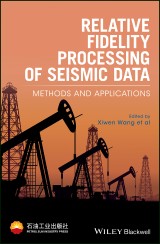Details

Relative Fidelity Processing of Seismic Data
Methods and Applications1. Aufl.
|
174,99 € |
|
| Verlag: | Wiley-Blackwell |
| Format: | EPUB |
| Veröffentl.: | 27.02.2017 |
| ISBN/EAN: | 9781119052920 |
| Sprache: | englisch |
| Anzahl Seiten: | 360 |
DRM-geschütztes eBook, Sie benötigen z.B. Adobe Digital Editions und eine Adobe ID zum Lesen.
Beschreibungen
<p>This book presents a comprehensive overview of relative fidelity preservation processing methods and their applications within the oil and gas sector. Four key principles for wide-frequency relative fidelity preservation processing are illustrated throughout the text. Seismic broadband acquisition is the basis for relative fidelity preservation processing and the influence of seismic acquisition on data processing is also analyzed. The methods and principles of Kirchhoff integral migration, one-way wave equation migration and reverse time migration are also introduced and illustrated clearly. Current research of relative amplitude preservation migration algorithms is introduced, and the corresponding numerical results are also shown.</p> <p>RTM (reverse time migration) imaging methods based on GPU/CPU systems for complicated structures are represented. This includes GPU/CPU high performance calculations and its application to seismic exploration, two-way wave extrapolation operator and boundary conditions, imaging conditions and low frequency noise attenuation, and GPU/CPU system based RTM imaging algorithms. Migration velocity model building methods in depth domain for complicated structures are illustrated in this book. The research status and development of velocity model building are introduced. And the impacting factors are also discussed. Several different velocity model building methods are also represented and analyzed. The book also provides the reader with several case studies of field seismic data imaging in different kinds of basins to show the methods used in practice. </p>
<p>Preface vii</p> <p><b>1 Study on Method for Relative Fidelity Preservation of Seismic Data 1</b></p> <p>1.1 Introduction 1</p> <p>1.2 Discussion on Impact on Processing of High?]resolution, High SNR for Seismic Acquisition and Observation Mode 3</p> <p>1.3 Discussion on the Cause of Notching 11</p> <p>1.4 Discussion of Impact on Processing of Relative Fidelity Preservation Seismic Data for Seismic Acquisition and Observation Mode 17</p> <p>1.5 Comparison of Results of High?]resolution, High SNR Processing and Relative Fidelity Preservation Processing 28</p> <p>1.6 Elastic Wave Forward Modeling 30</p> <p>1.7 Conclusions 33</p> <p>References 34</p> <p><b>2 Method and Principle for Seismic Migration and Imaging 37</b></p> <p>2.1 Kirchhoff Integral Prestack Depth Migration 37</p> <p>2.2 Amplitude Preservation Fourier Finite Difference Prestack Depth Migration Method 40</p> <p>2.3 Reverse Time Migration 46</p> <p>References 73</p> <p><b>3 Study of Reverse Time Migration Method for Areas With Complicated Structures Based on the GPU/CPU System 75</b></p> <p>3.1 Introduction 75</p> <p>3.2 The GPU/CPU High?]performance Calculation and Its Application in Seismic Exploration 77</p> <p>3.3 Study on the Two?]way Wave Extrapolation Operator and Its Boundary Conditions 82</p> <p>3.4 Study on the Imaging Condition and Low?]frequency Noise Suppression Method 91</p> <p>3.5 Study and Application of RTM Prestack Imaging Algorithm based on the GPU/CPU System 98</p> <p>3.6 Conclusions 111</p> <p>References 114</p> <p><b>4 Study and Application of Velocity Model Building Method for the Areas with Complicated Structures 117</b></p> <p>4.1 Introduction 117</p> <p>4.2 Status Quo and the Development of the Velocity Model Building Method 118</p> <p>4.3 Impacting Factors for the Velocity Model Building 120</p> <p>4.4 Study and Application of the Seismic Velocity Model Building Method 128</p> <p>4.5 Quality Monitoring and Accuracy Discussion of the Seismic Velocity Model Building 156</p> <p>4.6 Velocity Analysis Method for Reverse Time Migration in Angle Domain 162</p> <p>4.7 Study of the Full Waveform Inversion Method 172</p> <p>References 180</p> <p><b>5 Case Study 183</b></p> <p>5.1 Application of 3D Prestack Reverse Time Migration in Subsalt Imaging 183</p> <p>5.2 Application of High?]density All?]round Seismic Data Processing in the Carbonatite Region 210</p> <p>5.3 Application of Seismic Imaging Method for Complicated Structures in the Tuha and Jiuquan Basins 258</p> <p>5.4 Application of the Seismic Prestack Imaging Method in the Buried Hill Structural Zone in the Nanpu of Jidong Oilfield 303</p> <p>References 329</p> <p>Index 333</p>
<p> Dr. Xiwen Wang is the Vice President of the northwest Branch of the Petroleum Exploration and Development Research Institute, and is well known as a senior technical expert of CNPC. He has chaired numerous major sci-tech projects for CNPC, publishing nearly a hundred papers for domestic and international academic periodicals.
<p>This book presents a comprehensive overview of relative fidelity preservation processing methods and their applications within the oil and gas sector. Four key principles for wide-frequency relative fidelity preservation processing are illustrated throughout the text. Seismic broadband acquisition is the basis for relative fidelity preservation processing and the influence of seismic acquisition on data processing is also analyzed. The methods and principles of Kirchhoff integral migration, one-way wave equation migration and reverse time migration are also introduced and illustrated clearly. Current research of relative amplitude preservation migration algorithms is introduced, and the corresponding numerical results are also shown.</p> <p>RTM (reverse time migration) imaging methods based on GPU/CPU systems for complicated structures are represented. This includes GPU/CPU high performance calculations and its application to seismic exploration, two-way wave extrapolation operator and boundary conditions, imaging conditions and low frequency noise attenuation, and GPU/CPU system based RTM imaging algorithms. Migration velocity model building methods in depth domain for complicated structures are illustrated in this book. The research status and development of velocity model building are introduced, and the impacting factors are also discussed. Several different velocity model building methods are represented and analyzed. The book also provides the reader with several case studies of field seismic data imaging in different kinds of basins to show the methods used in practice.

















